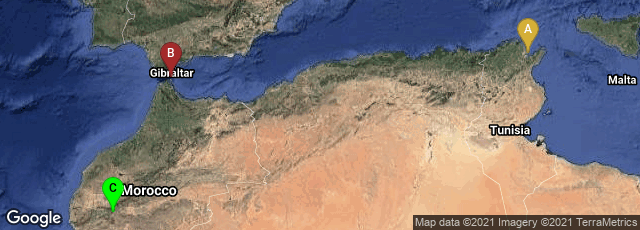
A: Amilcar, Site archéologique de Carthage, Tunis, Tunisia, B: (36,-5.35), C: Marrakech-Safi, Morocco
The periplus (literally "a sailing-around") of Hanno the Navigator, a Carthaginian colonist and explorer circa 500 BCE, which recounts his exploration of the West coast of Africa, is one of the earliest surviving manuscript documents listing in order the ports and coastal landmarks, with approximate distances between, that the captain of a vessel could expect to find along a shore.
In his periplus Hanno states that he brought new colonists to four Carthaginian settlements established where the chain of the Atlas Mountains reaches the Atlantic and then, having founded a new colony at the Tropic, proceeded from there to explore the coast of Africa as far as the Equator. It also contains a description of an active volcano and the first known report about gorillas.
Hanno's periplus survives in a single Byzantine manuscript, which also contains various other texts, and dates from the 9th or 10th century—Codex Heidelbergensis 398. A digital facsimile of the manuscript is available from the Universitätsbibliothek, Heidelberg at this link. Hanno's text was first edited for publication in print by Sigismund Gelenius, and issued from Basel in 1533. It was translated into English by Wilfred Schott and published as The Periplus of Hanno. A Voyage of Discovery Down the West African Coast by a Carthaginian Admiral of the Fifth Century B.C. (1912).
"The primary source for the account of Hanno's expedition is a Greek translation, titled Periplus, of a tablet Hanno is reported to have hung up on his return to Carthage in the temple of Ba'al Hammon whom Greek writers identified with Kronos. The full title translated from Greek is The Voyage of Hanno, commander of the Carthaginians, round the parts of Libya beyond the Pillars of Heracles, which he deposited in the Temple of Kronos. This was known to Pliny the Elder and Arrian, who mentions it at the end of his Anabasis of Alexander VIII (Indica):
" 'Moreover, Hanno the Libyan started out from Carthage and passed the Pillars of Heracles and sailed into the outer Ocean, with Libya on his port side, and he sailed on towards the east, five-and-thirty days all told. But when at last he turned southward, he fell in with every sort of difficulty, want of water, blazing heat, and fiery streams running into the sea" (Wikipedia article on Hanno the Navigator, accessed 05-30-2009).